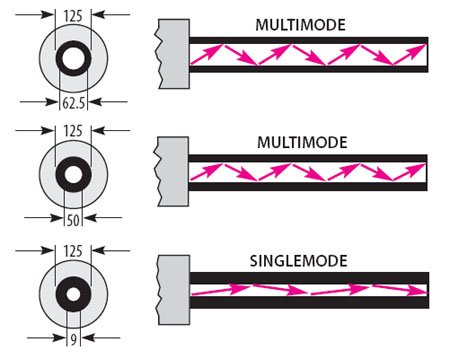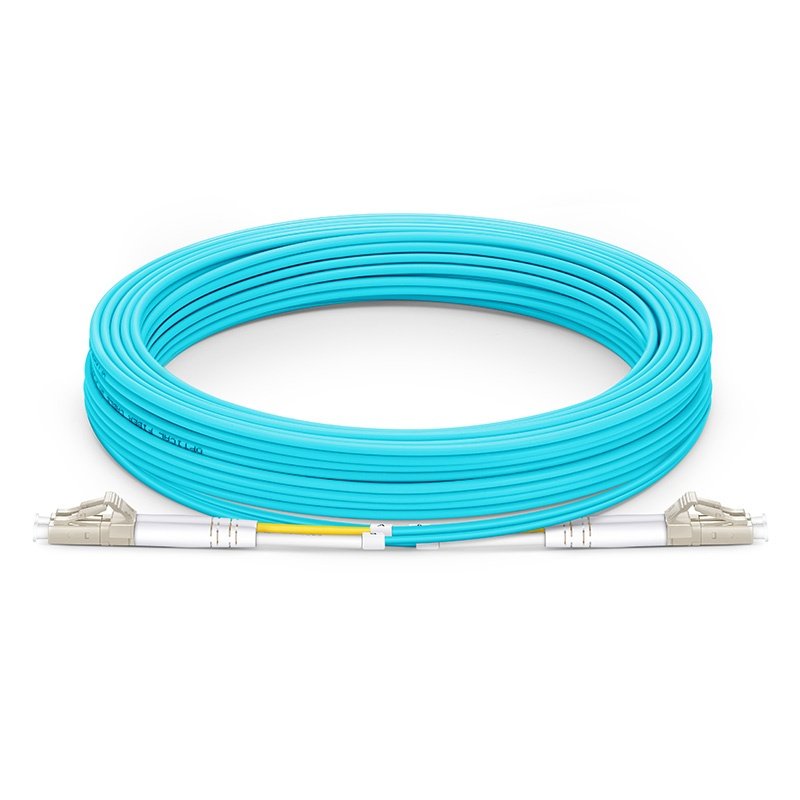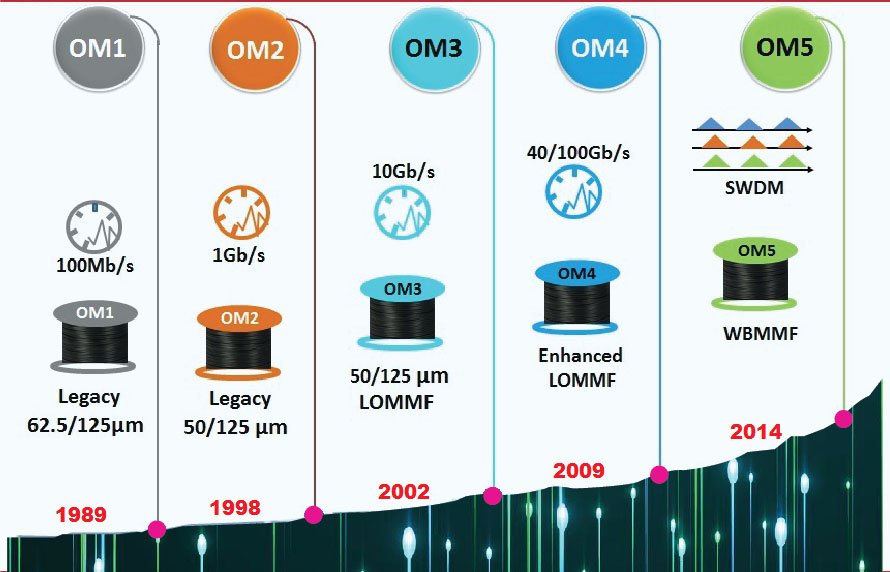Imagine multimode fibre as the bustling highways of short-range data networks—carrying multiple light signals at once, like lanes filled with traffic speeding toward their destinations. Unlike single mode fibre, which is built for long-haul precision, multimode fibre excels in environments like data centers, campuses, and office buildings, where distances are shorter but speed and cost matter. The question of OM1 vs OM2 vs OM3 vs OM4 vs OM5 defines this world, as these standards—set by TIA and ISO (TIA-568)—mark the evolution of multimode fibre performance. This guide breaks down each type—OM1, OM2, OM3, OM4, and OM5—comparing their specs, capabilities, and uses, while highlighting how CommMesh supplies these fibres for your network needs. Let’s dive into multimode fibre and see how OM1 vs OM2 vs OM3 vs OM4 vs OM5 shapes connectivity!
What Is Multimode Fibre?
Multimode fibre is a type of optical fibre designed to carry multiple light paths—or modes—simultaneously, making it ideal for high-speed, short-distance applications. Unlike single mode fibre, which uses a tiny 9-micron core for one light path over kilometers, multimode fibre has a larger core—typically 50 or 62.5 microns—allowing multiple modes to travel, though this limits distance due to modal dispersion (light paths arriving at slightly different times). In the debate of OM1 vs OM2 vs OM3 vs OM4 vs OM5, each type improves on this design, boosting bandwidth and reach for modern networks—think 10G, 40G, or even 100G over hundreds of meters.

The key to multimode fibre lies in its modal bandwidth—measured in MHz·km—which determines how much data it can carry before dispersion blurs the signal. OM1, the oldest, started this journey, while OM5, the newest, pushes the limits with advanced tech like Shortwave Wavelength Division Multiplexing (SWDM). From OM1’s humble beginnings to OM5’s cutting-edge potential, multimode fibre offers cost-effective solutions for short-haul needs—perfect for today’s data-driven world.
OM1 Multimode Fibre: The Original Standard
OM1 multimode fibre kicked off the multimode era with a 62.5-micron core—larger than later types—and a modest performance profile. Introduced in the 1980s, it was designed for early LED-based systems, supporting speeds like 100 Mbps over 2 km or 1 Gbps over 275m at 850 nm. In OM1 vs OM2 vs OM3 vs OM4 vs OM5, OM1 lags with a modal bandwidth of 200 MHz·km at 850 nm and 500 MHz·km at 1300 nm—enough for legacy Ethernet but not today’s high-speed demands—e.g., 10G drops to just 33m due to dispersion.
OM1’s thick core and low bandwidth make it a relic—think old office LANs or industrial setups still running Fast Ethernet. Its attenuation—around 3.5 dB/km at 850 nm—further limits reach compared to newer fibres. While cheap (e.g., $0.20/m), OM1 is fading as networks upgrade—rarely chosen today unless replacing existing runs.
OM2 Multimode Fibre: A Step Forward
OM2 multimode fibre shrank the core to 50 microns, boosting performance over OM1 with a cleaner light path. Launched in the 1990s, it doubles modal bandwidth to 500 MHz·km at 850 nm—still LED-friendly but better suited for 1 Gbps over 550m or 10 Gbps over 82m—key in OM1 vs OM2 vs OM3 vs OM4 vs OM5. Attenuation drops to ~3.0 dB/km at 850 nm, improving signal clarity over OM1’s chunkier core—e.g., a 1 km OM2 link loses 3 dB vs. OM1’s 3.5 dB.
OM2 fits small-to-mid-sized networks—e.g., campus backbones or early data centers—handling Gigabit Ethernet well but straining at 10G due to dispersion. Priced around $0.25/m, it’s a budget step up from OM1, though its 50-micron core aligns with later standards, easing compatibility—say, patching into OM3 systems. In multimode fibre evolution, OM2 bridges the gap but falls short of modern needs.
OM3 Multimode Fibre: Laser-Optimized Leap
OM3 multimode fibre marks a big jump, keeping the 50-micron core but optimizing for laser sources like VCSELs (Vertical-Cavity Surface-Emitting Lasers)—a game-changer in OM1 vs OM2 vs OM3 vs OM4 vs OM5. Introduced in the 2000s, it boasts 2000 MHz·km bandwidth at 850 nm—four times OM2—supporting 10 Gbps over 300m, 40 Gbps over 100m, or 1 Gbps over 1 km. Attenuation holds at ~3.0 dB/km, but laser precision cuts dispersion—e.g., a 300m OM3 link at 10G loses ~1 dB, fitting a 7 dB budget.

OM3 dominates data centers and enterprise LANs—e.g., connecting server racks or building floors—thanks to its 10G prowess and affordability (~$0.40/m). Its aqua jacket signals laser optimization, and in multimode fibre comparisons, OM3 balances cost and speed—ideal for growing networks needing more than OM2 can offer.
OM4 Multimode Fibre: Enhanced Performance
OM4 multimode fibre refines OM3, sticking with the 50-micron core but pushing bandwidth to 4700 MHz·km at 850 nm—over twice OM3’s capacity—in OM1 vs OM2 vs OM3 vs OM4 vs OM5. Launched around 2010, it extends 10 Gbps to 550m, 40 Gbps to 150m, and 100 Gbps to 100m—e.g., a 150m OM4 link at 40G loses ~0.5 dB, well within a 1.5 dB budget. Attenuation stays ~3.0 dB/km, but tighter manufacturing—e.g., better core uniformity—slashes dispersion further.
OM4 suits high-density data centers and campus networks—e.g., 40G backbones or future-proofing for 100G—costing ~$0.60/m. Its aqua jacket matches OM3, but superior specs make it a go-to for upgrades—e.g., replacing OM3 in a 200m run to hit 40G reliably. In multimode fibre stakes, OM4 raises the bar for speed and reach.
OM5 Multimode Fibre: The Future-Ready Option
OM5 multimode fibre—introduced in 2016—takes multimode fibre to new heights with the same 50-micron core but a twist: it’s optimized for Shortwave Wavelength Division Multiplexing (SWDM), using 850-950 nm wavelengths. In OM1 vs OM2 vs OM3 vs OM4 vs OM5, OM5 matches OM4’s 4700 MHz·km at 850 nm but supports 40 Gbps over 440m or 100 Gbps over 150m with SWDM—e.g., multiplexing four 25G channels at 880/910/940 nm over 150m with ~0.5 dB loss. Attenuation is ~3.0 dB/km at 850 nm, dropping slightly at higher wavelengths.
OM5’s lime-green jacket signals its SWDM edge, ideal for next-gen data centers—e.g., 100G SWDM4 over 200m—costing ~$0.80/m. It’s backward-compatible with OM4 but shines with advanced optics—e.g., doubling capacity on existing runs—making it the forward-thinking pick in multimode fibre evolution.

Technical Specs: OM1 vs OM2 vs OM3 vs OM4 vs OM5
Comparing multimode fibre types head-to-head clarifies OM1 vs OM2 vs OM3 vs OM4 vs OM5.
- Core Size: OM1: 62.5 μm; OM2-OM5: 50 μm—smaller cores reduce dispersion.
- Bandwidth (850 nm): OM1: 200 MHz·km; OM2: 500 MHz·km; OM3: 2000 MHz·km; OM4/OM5: 4700 MHz·km—higher bandwidth boosts speed and distance.
- 10G Reach (850 nm): OM1: 33m; OM2: 82m; OM3: 300m; OM4: 550m; OM5: 550m (non-SWDM)—OM5’s SWDM adds versatility.
- 40G/100G Reach: OM1/OM2: N/A; OM3: 100m/70m; OM4: 150m/100m; OM5: 440m/150m (SWDM)—later types excel at high speeds.
- Attenuation (850 nm): OM1: 3.5 dB/km; OM2-OM5: ~3.0 dB/km—tighter specs improve signal.
In multimode fibre, OM1 and OM2 lag, while OM3, OM4, and OM5 lead—CommMesh stocks them all.
Applications of Multimode Fibre Types
Multimode fibre fits specific niches in OM1 vs OM2 vs OM3 vs OM4 vs OM5. OM1 suits legacy LANs—e.g., 100 Mbps over 1 km in old offices—while OM2 handles 1G campus links—e.g., 550m between buildings. OM3 powers 10G data centers—e.g., 300m server racks—balancing cost and speed—e.g., $1000 for a 500m run vs. single mode’s $3000. OM4 steps up for 40G/100G—e.g., 150m backbone in a tech firm—while OM5 preps for future 400G—e.g., 150m SWDM in a cloud facility.
Upgrade paths vary—e.g., OM1-to-OM3 swaps need new cables (62.5 μm to 50 μm mismatch), but OM3-to-OM4 reuses runs with better optics—saving ~$500 on a 200m refit. Multimode fibre adapts to needs—OM5 leads the charge.
Cost and Availability in Multimode Fibre
Cost shapes OM1 vs OM2 vs OM3 vs OM4 vs OM5 choices. OM1 ($0.20/m) and OM2 ($0.25/m) are cheapest—abundant for legacy fixes—e.g., $200 for a 1 km OM2 patch. OM3 ($0.40/m) and OM4 ($0.60/m) rise with performance—e.g., $600 for a 1 km OM4 run—widely available from suppliers like CommMesh. OM5 (~$0.80/m) costs more—e.g., $800 for 1 km—but SWDM savings offset optics costs—e.g., $2000 less vs. single mode for 100G over 150m.
Stock varies—OM1/OM2 dwindle as OM3/OM4 dominate—e.g., 80% of 2025 data center fibre—while OM5 grows—10% adoption by 2023 (Fibre Optics Market Report). Multimode fibre pricing reflects its evolution—CommMesh offers all grades.
Choosing the Right Multimode Fibre Type
Picking multimode fibre in OM1 vs OM2 vs OM3 vs OM4 vs OM5 hinges on needs. For legacy 1G under 500m—e.g., an old factory LAN—OM1 or OM2 suffices—cheap and simple—e.g., $100 for 500m OM2. For 10G data centers—e.g., 200m server links—OM3 fits—$400 for 1 km—while 40G/100G over 150m calls for OM4—$600 for 1 km—balancing cost and future use. OM5 shines for 100G+ with SWDM—e.g., 200m cloud backbone—$800 for 1 km—cutting long-term costs.
Distance and budget guide—e.g., OM3 for a 100m 10G run ($40) vs. OM4 for a 200m 40G run ($120)—OM5 if scaling to 400G looms—e.g., $160 for 200m SWDM-ready. Multimode fibre choice is strategic—CommMesh has options for all.
Conclusion: Navigating OM1 vs OM2 vs OM3 vs OM4 vs OM5
Multimode fibre powers short-range networks with versatility—from OM1’s humble start to OM5’s SWDM frontier—like a toolkit growing sharper with each generation. This guide has dissected OM1 vs OM2 vs OM3 vs OM4 vs OM5, comparing their specs, uses, and costs, showing how multimode fibre evolves for speed and scale. Whether it’s OM3 for today’s 10G or OM5 for tomorrow’s 400G, CommMesh supplies the right multimode fibre for your setup—starting at $0.20/m. Choose wisely and build a network that lasts!

